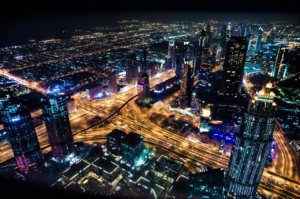“Humanity is crowding into ever smaller portions of the planet,” writes N.L. in an article in The Economist. “In ‘Triumph of the City‘ Edward Glaeser notes how 243m Americans squish together into only 3% of the country’s area. Such concentration has always made cities engines of innovation. Florence spawned the Renaissance and Birmingham the Industrial Revolution.” [“The city triumphs, again,” 6 June 2013] Over half of the world’s population now lives in urban areas and the world continues to urbanize. Geoff Zeiss notes that this urbanization trend means that you have to start thinking about “megaregions” rather than simply “megacities.” [“Increased urbanization is creating megaregions,” Between the Poles, 18 June 2013] He explains:
“A megaregion is a new scale of geography that blurs the traditional boundaries between metropolitan regions. … These population centers include Interlocking economic systems, shared natural resources and ecosystems, and common transportation systems. Population growth and increasing urbanization are the driving forces behind megaregions. America2050 has defined 11 megaregions in the United States [click to enlarge image]. Megaregions are defined by relationships that define a common interest. According to Amerca2500 the five major categories of relationships that define megaregions are:
- Environmental systems and topography
- Infrastructure systems
- Economic linkages
- Settlement patterns and land use
- Shared culture and history
“Most of a country’s rapid population growth and economic expansion is expected to occur in these megaregions.”
For a lot reasons, thinking about megaregions make sense; however, when it comes to improving the quality of life for people who live in urban environments, it makes more sense to think smaller — at the level of neighborhoods and streets. At this micro-level, Kaid Benfield reports that more urban planners are considering things like “complete streets, … which assure that street design and management account for pedestrians, transit users and bicyclists in addition to motorists.” [“Complete streets policies are gaining popularity across the country,” NRDC Switchboard, 27 April 2011] In a later post, he wrote about the walkability of city streets. [“For walkable cities, it’s not about the density – it’s about finding the right kind of density,” NRDC Switchboard, 4 March 2013] One concern that is often left out of such discussions is the issue of logistics. As more and more people crowd into urban spaces, more and more goods also need to get into and out of urban areas. Walkable streets may be great for reducing pollution and encouraging exercise, but they play havoc with logistics systems. Benfield admits, “In truth, we need more sophisticated and nuanced answers. They may be elusive and often site-specific, but they are also critical to building a better world for our children, ourselves, and the planet.” [“10 Ways to Improve High-Density Cities,” The Atlantic, 13 February 2013] In our attempt to build a better urban environment for ourselves and our posterity, Benfield and others have suggested some principles we should keep in mind. As the headline from Benfield’s last cited article notes, he begins the conversation by offering ten principles suggested by the Urban Land Institute. They are:
1. Plan for long-term growth and renewal.
2. Embrace diversity, foster inclusiveness.
3. Draw nature closer to people.
4. Develop affordable, mixed-use neighborhoods.
5. Make public spaces work harder.
6. Prioritize green transport and building options.
7. Relieve density with variety and add green boundaries.
8. Activate spaces for greater safety.
9. Promote innovative and non-conventional solutions.
10. Forge “3P” (people, public, private) partnerships.
Bill Adams contributes to the discussion by suggesting “10 Rules for Smarter Smart Growth” to which he adds “a bonus rule” making 11 rules in all. [San Diego UrbDeZine, 16 April 2013] They are:
1. Purge the term NIMBY from your language and your thinking. [NIMBY stands for “not in my backyard.” Adams believes this kind of thinking “stultifies any further understanding of community concerns, or how to reach a compromise.”]
2. Respect community planning. [If you don’t like what’s being planned, involve yourself in the process.]
3. Integrate with the surrounding community. [This is especially important when a megaregion is involved.]
4. In transit oriented developments (TODs), transit orientation should exceed auto orientation. [Don’t forget to consider how goods must move in about the urban environment.]
5. Respect neighborhood character & identity. [The last thing you want to create is a sterile and unexciting environment.]
6. Increase density incrementally. [Adams believes that “incremental methods are especially important in communities that are not blighted or depressed.”]
7. Conform to existing “smart” retail corridors and centers. [Adam’s writes, “A successful smart growth project doesn’t add a large amount of retail space on the periphery of an existing successful or resurging commercial district.”]
8. Look for opportunities to narrow (verb) streets and vanquish parking lots. [This “suggestion” once again needs to take into consideration how the goods people need are going to get into and out of the city.]
9. Prioritize non-auto transportation by creating unique or exclusive pedestrian and bicycle amenities. [Adams, who apparently lives in San Diego, seems almost oblivious to harsh winter conditions that are not conducive to pedestrian or bicycle traffic. The priority should be on providing safe, affordable, and convenient transportation. Remove any one of those characteristics and you are undermining usage.]
10. Design for human nature, honed over millions of years, rather than efficiencies and logic, decided upon during the course of design. [Big Data analytics can help planners understand how real people live, work, and play in the urban environment. Adams writes, “Smart growth, new urbanism, densification, transit oriented development, and related concepts are in danger of triggering a backlash from heavy handed application.”]
11 .[Bonus rule ] Preserve and enhance existing density and urban fabric. [Adam’s writes, “Allow or encourage adaptive reuse which modifies non-historic structures (or non-historic components of historic structures) to achieve increased density.”]
After reading Adams’ eleven rules, Benfield decided to add five more of his own. [“16 Rules for ‘Smarter’ Smart Growth,” The Atlantic, 1 May 2013] They are:
1. “Integrate nature into the community, especially at the neighborhood scale, as with pocket parks, green infrastructure, street trees and the like. We humans need that sort of thing, and too many developers and municipalities today don’t bother.
2. “Integrate green technology into buildings and infrastructure. In this day and age, smart growth just isn’t very smart unless it takes every opportunity to reduce emissions and resource consumption. And it’s the performance, not the technology, that matters.
3. “Employ universal access and age-friendly design. By 2030, there will be over 40 seniors in the U.S. for every 100 persons of working age. We baby boomers aren’t going away, so let’s get ready.
4. “Make urbanism more family-friendly, too. We are building better cities with smart growth, but for whom? Do we really want to keep turning a blind eye to such a major segment of our population? In Washington, almost all of the city’s population increase over the past decade can be accounted for by an increase in residents between 20 and 35 years old. The number of children younger than 15 dropped by a fifth. I believe we need to change that and, for planners, that means better schools, better parks and playgrounds, and at least some moderate (rather than high) density housing with a little yard space.
5. “Pursue communities suitable for a diversity of incomes, housing types, ethnicities, and old/new residents. That’s the future of America; surely it should also be the future of smart growth.”
All things considered, those are some pretty good principles to keep in mind as we plan for continued urbanization in the United States. Clearly, some of these principles won’t work in global areas where urban growth has gone unchecked. New principles will have to be developed for how to make urban life better for those that live in such situations. There are so many things that need to be considered when conducting city planning it simply makes sense to use all available resources, including Big Data analysis and cognitive computing to help provide understanding and insight. As you might have noticed, only a few of the “principles” discussed above involved technology. Technology, however, is essential if cities are going to operate efficiently and effectively. I suspect that someone has developed another set of rules that apply to how technology should be used in helping create smarter cities. The one thing I strongly agree with is that smart growth is only smart if people’s lives are improved in the process.




